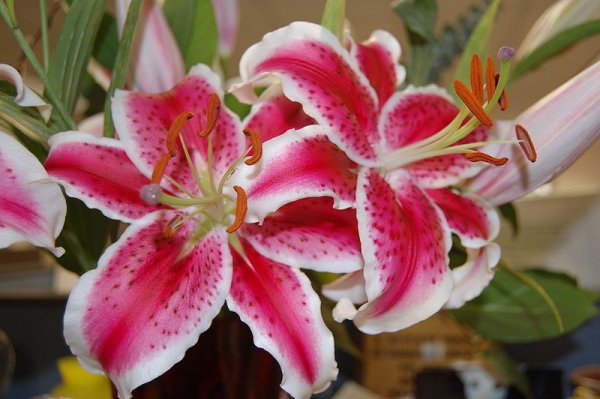Lilium Gardening Tips   
| ||||
|
Lilium is a genus of flowering plants in family Liliaceae, comprising about 110 species. Most species are native to the temperate Northern Hemisphere. It is commonly known as Lily. The species in this genus are the true lilies. Many other plants exist with 'lily' in their common English names, some are not quite related to the true lilies. Like dahlias and daffodils, lilies are a huge group of plants and are classified in nine divisions, some of which are further categorized according to flower shape. Division I : Asiatic hybrids - The hybrids are sturdy, stem-rooting lilies. They are derived from the central and East Asian species. They are medium sized and bear mostly unscented, upright, outward facing or pendent flowers. L.'Apollo', 60 cm, with unscented white flowers; L.'Fata Morgana', 70 cm, bears double, yellow flowers. Division II : Martagon hybrids - The hybrids are mainly stem-rooting lilies. The plants are based on L. martagon and L. hansonii. They produce flowers that are nodding, Turk's cap style (recurved petals). They tolerate a range of conditions, including dry shade. L. 'Marhan' 1.5 m, has orange turkscap flowers. Division III : Candidum hybrids - This includes hybrids of L. candidum and several other mostly European species. The hybrids have turkscap flowers and are not usually stem rooting. They can tolerate alkaline soil. L. x testaceum (Nankeen lily), 1.5 m, has up to 12 light apricot-pink flowers, lightly spotted with red. Division IV : American hybrids - Many plants in this divisions are of taller growing forms, originally derived from L. pardalinum. Many are clump-forming perennials. The hybrids are rhizomatous lilies with often scented, usually turkscap flowers. They are not stem rooting. Bellingham hybrids have flowers that range in striking color from yellow to orange, and orange-red, all are spotted with red-brown. The hybrids prefers acidic, moist soil and are good for naturalizing in light shade. Division V : Longiflorum hybrids - The hybrids have been developed from L. formosanum and L. longiflorum. The flowers are fragrant, trumpet- or funnel-shaped and are often used as cut flowers. The hybrids can tolerate a range of soils, including alkaline conditions, but they are not hardy plants. L. 'Casa rosa', 1 meter, has white, pink-flushed flowers; L. 'White America', 1 meter, has green-tipped white flowers. Division VI : Trumpet and Aurelian hybrids - The hybrids of many Asiatic species, including L. regale and L. aurelianse. The hybrids are mostly hardy, fragrant, stem rooting lilies which can tolerate alkaline conditions. This group also includes the Golden Splendor Group, 1.8 m, with scented, yellow and dark red flowers; and L. 'White Henryi', 1.5 m, with large, fragrant, orange-flushed flowers. Division VII : Oriental hybrids - This group is based on hybrids of L. auratum and L. speciosum, together with crossbreeds from several mainland Asiatic species. The hybrids are mostly scented and flower in late summer and prefer acidic soil. L. 'Hotlips' has fragrant white flowers, streaked and spotted with red. L. 'Stargazer' has rose-red flowers, edged in white. Division VIII : Other hybrids - Hybrids not included in other divisions are known simply as 'Other Hybrids'. L. x dalhansonii bears small, maroon, turkscap flowers. L. 'Moneymaker', 1 meter, has flowers that are clear pink in midsummer. Division IX : Species lilies and their true forms - This group includes all natural species and naturally occurring forms. This division includes some of the most beautiful and best-known of all plants. L. auratum (golden-rayed lily) prefers acidic soil and full sun, has fragrant, white and gold flowers. L. candidum (Madonna lily) has scented, trumpet-shaped, white flowers of 8 cm long L. regale (regal lily), 1.8 m, has trumpet-shaped, fragrant, white flowers, streaked with purple on the reverse; not only is this the most beautiful of all lilies, it is also the easiest to grow, tolerating most conditions (except very alkaline soil), but need staking to support its lovely flowers. Some species have been developed especially without stamens, for those with pollen allergy. Look out for species with the 'Kiss' in their name. Lilium prefers sun and well drained soil. Propagation of lilies can be done by ripe seed; remove scales; offsets or bulbets from dormant bulbs; remove bulbils from stems in late summer. Pest and diseases are aphids, lily beetle, and grey mould.  Lilium 'Stargazer' Author: Cavs Lady (Creative Commons Attribution ShareAlike 3.0-unported) Lilium auratum Author: Denis Barthel (Creative Commons Attribution-Share Alike 2.0 Germany) Lilium candidum Author: Magnus Manske (Creative Commons Attribution-Share Alike 2.5 Generic)  Lilium regale Author: Epibase (Creative Commons Attribution-Share Alike 2.5 Generic) Lilium speciosum Author: Poposhka (public domain) Lilium hansonii Author: Ram-Man (Creative Commons Attribution ShareAlike 3.0) Lilium martagon Author: Maedin Tureaud (Creative Commons Attribution ShareAlike 3.0-unported) Lilium pardalinum Author: Thorkild Poulsen (Creative Commons Attribution-Share Alike 2.5 Generic) Lilium longiflorum Author: Solipsist (Creative Commons Attribution 2.0 Generic) Lilium rosthornii Author: Denis Barthel (Creative Commons Attribution 2.0 Generic) Lilium 'Citronella' Author: Ram-Man (Creative Commons Attribution ShareAlike 3.0) | ||||
|


